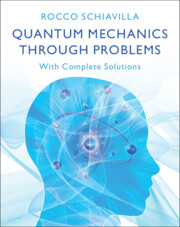Refine search
Actions for selected content:
3190 results in Mathematical Methods
18 - Time-Dependent Perturbation Theory
-
- Book:
- Quantum Mechanics through Problems
- Published online:
- 05 December 2024
- Print publication:
- 12 December 2024, pp 669-725
-
- Chapter
- Export citation
11 - Angular Momentum: General Properties
-
- Book:
- Quantum Mechanics through Problems
- Published online:
- 05 December 2024
- Print publication:
- 12 December 2024, pp 332-364
-
- Chapter
- Export citation
4 - The One-Dimensional Schrödinger Equation; Bound States
-
- Book:
- Quantum Mechanics through Problems
- Published online:
- 05 December 2024
- Print publication:
- 12 December 2024, pp 61-93
-
- Chapter
- Export citation
19 - Systems of Identical Particles
-
- Book:
- Quantum Mechanics through Problems
- Published online:
- 05 December 2024
- Print publication:
- 12 December 2024, pp 726-754
-
- Chapter
- Export citation
2 - Wave–Particle Duality andWave Mechanics
-
- Book:
- Quantum Mechanics through Problems
- Published online:
- 05 December 2024
- Print publication:
- 12 December 2024, pp 18-35
-
- Chapter
- Export citation
17 - Rotation Matrices and the Wigner–Eckart Theorem; Fine and Hyperfine Structure of Energy Levels in Hydrogen-Like Atoms
-
- Book:
- Quantum Mechanics through Problems
- Published online:
- 05 December 2024
- Print publication:
- 12 December 2024, pp 622-668
-
- Chapter
- Export citation
10 - Bound States in a Central Potential: Applications
-
- Book:
- Quantum Mechanics through Problems
- Published online:
- 05 December 2024
- Print publication:
- 12 December 2024, pp 291-331
-
- Chapter
- Export citation
16 - Symmetry Transformations of States and Operators
-
- Book:
- Quantum Mechanics through Problems
- Published online:
- 05 December 2024
- Print publication:
- 12 December 2024, pp 582-621
-
- Chapter
- Export citation
Preface
-
- Book:
- Quantum Mechanics through Problems
- Published online:
- 05 December 2024
- Print publication:
- 12 December 2024, pp xix-xx
-
- Chapter
- Export citation
Dedication
-
- Book:
- Quantum Mechanics through Problems
- Published online:
- 05 December 2024
- Print publication:
- 12 December 2024, pp v-vi
-
- Chapter
- Export citation
3 - Schrödinger Equation; Uncertainty Relations
-
- Book:
- Quantum Mechanics through Problems
- Published online:
- 05 December 2024
- Print publication:
- 12 December 2024, pp 36-60
-
- Chapter
- Export citation
Frontmatter
-
- Book:
- Quantum Mechanics through Problems
- Published online:
- 05 December 2024
- Print publication:
- 12 December 2024, pp i-iv
-
- Chapter
- Export citation
Bibliography
-
- Book:
- Quantum Mechanics through Problems
- Published online:
- 05 December 2024
- Print publication:
- 12 December 2024, pp 755-755
-
- Chapter
- Export citation

Quantum Mechanics through Problems
- With Complete Solutions
-
- Published online:
- 05 December 2024
- Print publication:
- 12 December 2024
Preface
-
- Book:
- A Computational Introduction to Quantum Physics
- Published online:
- 24 April 2024
- Print publication:
- 25 April 2024, pp xi-xii
-
- Chapter
- Export citation
Dedication
-
- Book:
- A Computational Introduction to Quantum Physics
- Published online:
- 24 April 2024
- Print publication:
- 25 April 2024, pp v-vi
-
- Chapter
- Export citation
7 - Beyond the Schrödinger Equation
-
- Book:
- A Computational Introduction to Quantum Physics
- Published online:
- 24 April 2024
- Print publication:
- 25 April 2024, pp 130-151
-
- Chapter
- Export citation
9 - Some Perspective
-
- Book:
- A Computational Introduction to Quantum Physics
- Published online:
- 24 April 2024
- Print publication:
- 25 April 2024, pp 165-170
-
- Chapter
- Export citation
Contents
-
- Book:
- A Computational Introduction to Quantum Physics
- Published online:
- 24 April 2024
- Print publication:
- 25 April 2024, pp vii-x
-
- Chapter
- Export citation
2 - The Schrödinger Equation
-
- Book:
- A Computational Introduction to Quantum Physics
- Published online:
- 24 April 2024
- Print publication:
- 25 April 2024, pp 16-36
-
- Chapter
- Export citation
